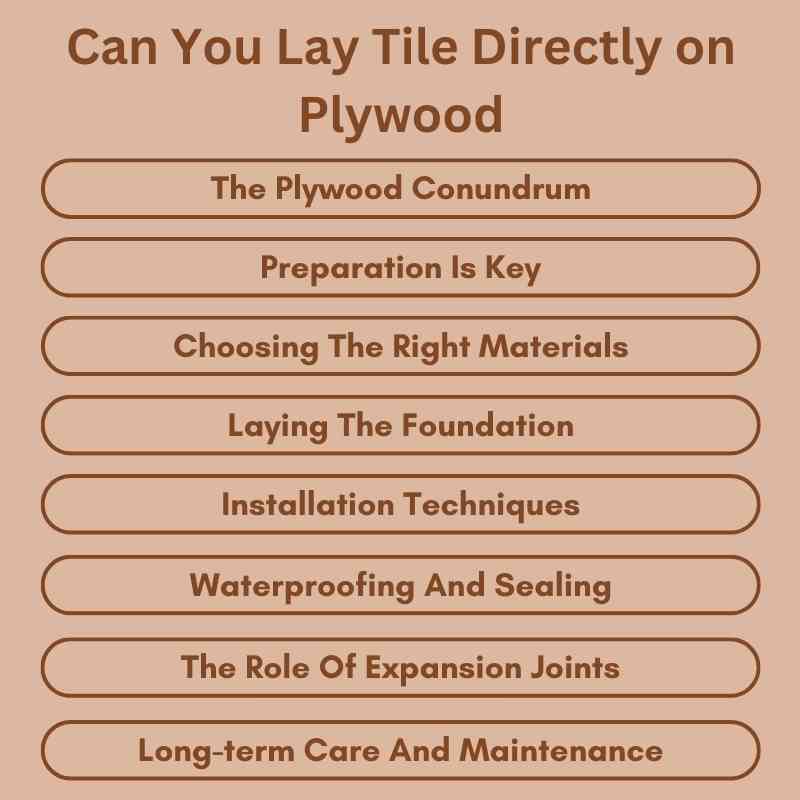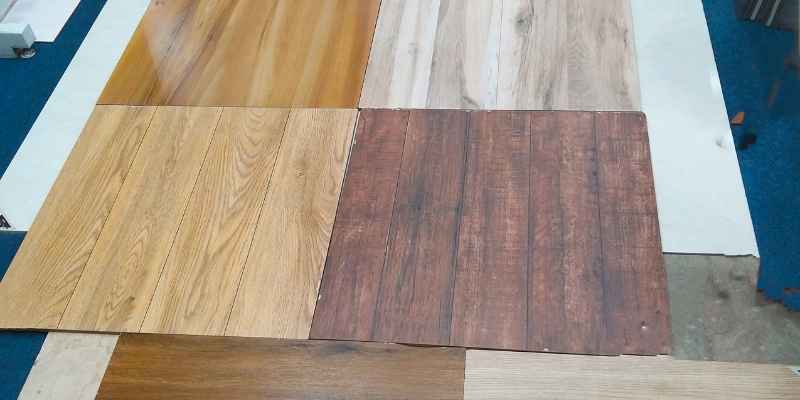You cannot lay tile directly on plywood. Doing so can lead to cracking and other issues due to movement in the plywood.
Tile installation requires a stable and moisture-resistant substrate. Plywood lacks the rigidity and durability needed for tile. Over time, the plywood can expand, contract, or warp, compromising the integrity of the tiles. To ensure a long-lasting installation, use a cement backer board or a tile underlayment over the plywood.
These materials provide a solid surface that can withstand the stresses of tile installation. Proper preparation and the right materials are crucial for a successful project. Taking these steps will help prevent costly repairs and ensure your tiled surfaces remain beautiful and functional for years to come.
The Plywood Conundrum
Plywood is a common choice for flooring. It provides a sturdy base for tiles. Tiling over plywood has both benefits and drawbacks.
Pros:
- Quick installation process saves time.
- Lightweight material is easier to handle.
- Plywood can absorb some moisture.
Cons:
- Wood can expand and contract with temperature changes.
- Inadequate support may lead to tile cracking.
- Moisture can weaken the bond over time.
Tile adhesion on plywood depends on the quality of the plywood. Use exterior-grade plywood for better results. Ensure the surface is clean and dry before tiling.

Preparation Is Key
Check the plywood condition before laying tile. Look for cracks or warping. If the plywood is damaged, repairs are needed. Ensure the surface is clean and dry.
Surface treatments are important. Use a primer to prepare the plywood. This helps the tile adhere better. For best results, consider using a backer board. It provides extra support and moisture resistance.
Choosing The Right Materials
Choosing the right materials is important for a successful tile installation. Tiles made from ceramic, porcelain, or vinyl work well on plywood. They offer durability and a good appearance.
For best results, select tiles that are lightweight. Heavy tiles can crack or damage the plywood beneath. Look for tiles with a smooth surface for easier cleaning.
Using the right adhesives is crucial for plywood surfaces. Thin-set mortar is a common choice for tile installation. It provides strong bonding and flexibility.
Modified thin-set can also be used for added strength. Mastic is another option but works best for dry areas. Always check the product label for compatibility with plywood.
Laying The Foundation
Choosing the right plywood thickness is key for tile stability. A minimum of 1/2 inch thick plywood is recommended. This thickness helps prevent cracking and movement.
Using an underlayment can further improve durability. Options include cement backer board and membrane systems. Each option provides a strong base for tiles. Underlayment helps manage moisture and reduces cracks.
| Underlayment Option | Benefits |
|---|---|
| Cement Backer Board | Water-resistant and strong |
| Membrane Systems | Flexible and moisture barrier |
Installation Techniques
To lay tile directly on plywood, start by preparing the surface. Ensure the plywood is clean and dry. Next, check for any loose spots or damage. Use a level to confirm the surface is even.
Apply a thin-set mortar on the plywood. Use a notched trowel to spread the mortar evenly. Press the tiles firmly into the mortar. Leave small gaps between the tiles for grout.
After placing all tiles, allow the mortar to cure. This usually takes 24 hours. Once cured, fill the gaps with grout. Clean the excess grout from the tiles.
Common mistakes include not using backer board or applying too much mortar. Avoid rushing through the drying times. Always follow manufacturer instructions for best results.
Waterproofing And Sealing
Waterproofing and sealing are crucial for tile installation on plywood. Moisture barriers protect the wood from water damage. Without these barriers, plywood can warp or rot over time.
Using a moisture barrier is essential. It keeps water from seeping through the tile and damaging the floor. Several sealing solutions exist for plywood floors.
| Sealing Solution | Description |
|---|---|
| Sheet Membrane | A thick layer that prevents moisture from reaching the plywood. |
| Liquid Membrane | Easy to apply and forms a protective coat over the surface. |
| Sealant | Painted on to create a waterproof layer. |
Selecting the right sealing solution ensures a long-lasting tile installation. Proper application of these solutions will help maintain the integrity of the plywood.
The Role Of Expansion Joints
Expansion joints are important for tile installation on plywood. They help manage expansion and contraction caused by temperature changes. Without them, tiles may crack or buckle.
To manage plywood expansion, place joints every 8 to 12 feet. Use flexible materials for these joints. This allows the plywood to move without harming the tiles.
Placement strategies for expansion joints include:
- Near walls and fixed objects
- In large areas, divide the space
- In high-moisture areas, like bathrooms
Following these strategies ensures a durable and long-lasting tile installation.
Long-term Care And Maintenance
Routine upkeep for tiled plywood surfaces is essential for longevity. Regularly sweep and mop to keep tiles clean. Use a gentle cleaner to avoid damaging the surface. Inspect grout lines for cracks or stains. Reapply grout sealant every 6 to 12 months to protect against moisture.
For repair tips on plywood-based tile floors, check for loose tiles. Remove the tile and inspect the plywood underneath. If the plywood is damaged, replace it. Apply thin-set mortar before reattaching the tile. Ensure tiles are level to avoid future issues.
Expert Insights
Tile installation over plywood can be tricky. Proper preparation is essential for lasting results. Experts recommend using thick plywood for better support. Thin plywood may lead to cracks and shifts in tiles.
Some professionals suggest adding a cement backer board. This adds stability and moisture resistance. It can help prevent tile damage over time.
Case studies show mixed results. Many homeowners experienced success with the right materials. Others faced failures due to inadequate prep work. Understanding these outcomes is key to making informed choices.
| Outcome | Details |
|---|---|
| Success | Using thick plywood and cement board |
| Failure | Thin plywood without proper prep |

Frequently Asked Questions
Can You Install Tile On Plywood?
No, installing tile directly on plywood is not recommended. Plywood lacks the necessary stability and moisture resistance for tile. Using a cement backer board or an appropriate underlayment is crucial for a successful tile installation. This helps prevent cracking and ensures a longer-lasting finish.
What Is The Best Underlayment For Tile?
The best underlayment for tile is cement backer board. It provides a solid, moisture-resistant surface that enhances adhesion. Additionally, it helps absorb movement, reducing the risk of tile cracking. Ensure the underlayment is properly installed for optimal results.
How Thick Should Underlayment Be For Tile?
Underlayment for tile should typically be 1/4 to 1/2 inch thick. This thickness allows for proper support and stability. It also ensures that the tile adheres well and minimizes the risk of damage. Always follow manufacturer guidelines for the best outcomes.
Can I Tile Over Existing Tile?
Yes, you can tile over existing tile if the surface is stable. Ensure the old tile is clean and free of debris. Additionally, check for any loose tiles that need repair. Proper preparation will lead to a successful new tile installation.
Conclusion
Laying tile directly on plywood can lead to issues like cracking and uneven surfaces. It’s essential to prepare the subfloor properly. Using a cement backer board or an appropriate underlayment will ensure a stable foundation. This investment will enhance the durability and appearance of your tiled surface for years to come.

